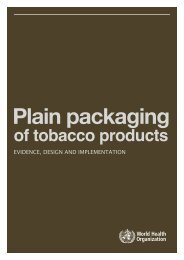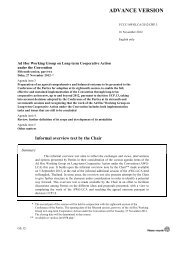PRIVATE PATENTS AND PUBLIC HEALTH
private-patents-and-public-health
private-patents-and-public-health
Create successful ePaper yourself
Turn your PDF publications into a flip-book with our unique Google optimized e-Paper software.
<strong>PRIVATE</strong> <strong>PATENTS</strong> <strong>AND</strong> <strong>PUBLIC</strong> <strong>HEALTH</strong><br />
In parallel to this process, the first generic ARVs began to be<br />
manufactured in India. Demand spurred by their designation as<br />
‘essential’ coupled with their prequalification by the WHO 217 and a<br />
concerted international effort to mobilise funding to treat HIV created<br />
a market for robust generic competition.<br />
The HIV crisis demonstrated both 1) the need for medically important<br />
drugs to be included on the list and 2) the power of EML inclusion as an<br />
impetus for bringing prices down.<br />
Table 10, above, shows that a number of the new essential medicines on<br />
the list are subject to patents, and that the expiry date of those patents are<br />
far in the future. Without deliberate action by governments and<br />
companies — as was taken to provide access to HIV treatment — these<br />
medicines will not become affordable.<br />
The EML is a tool for the practical implementation of the internationally<br />
agreed principle that IP should not stand in the way of measures to<br />
promote the human right to public health. Affordability is no longer a<br />
prerequisite for inclusion of a medicine in the EML; instead, inclusion<br />
must become a reason to ensure that treatments become affordable and<br />
thereby a ground — if not an obligation — for governments to act when<br />
pricing of essential medicines prohibits their use by people in need.<br />
THE CHALLENGES OF HEPATITIS C, CANCER, <strong>AND</strong> BIOSIMILARS<br />
The medicines added to the EML in May 2015 present a key opportunity<br />
to exercise the EML as a tool for access. The game-changing treatments<br />
for hepatitis C, several cancers, and tuberculosis now on the EML are as<br />
badly needed as they are currently priced out of reach.<br />
HEPATITIS C<br />
Chronic hepatitis C, for example, affects 130–150 million people<br />
globally, and liver diseases associated with it kill 300–500,000 people a<br />
year. Additionally, 5.5 million people are co-infected with hepatitis C and<br />
HIV and consequentially suffer increased rates of both HIV-related and<br />
liver-related illnesses.<br />
The new essential medicines to treat hepatitis C are effective enough to<br />
provide a cure for all. Until recently, treatment for hepatitis C was:<br />
difficult to administer (requiring regular hospital visits and extensive<br />
monitoring); difficult to undergo (requiring daily or weekly injections<br />
and several pills a day, and frequently causing debilitating side-effects);<br />
103






